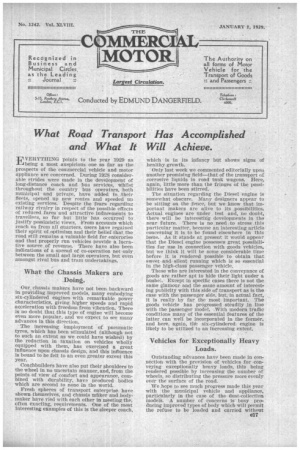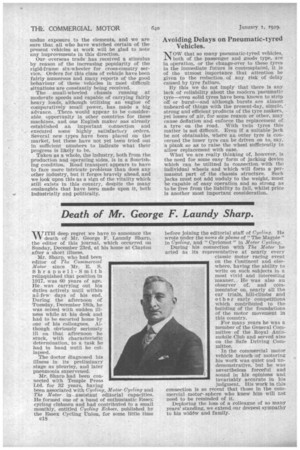What Road Transport Has Accomplished and What It Will Achieve.
Page 1

Page 2

If you've noticed an error in this article please click here to report it so we can fix it.
TI VERYTHING points to the year 1929 as A I being a most auspicious one so far as the prospects of the commercial vehicle and motor appliance are concerned. During 1928 considerable strides were made in the development of long-distance coach and bus services, Whilst throughout the country bus operators, :both municipal and private, have added to their fleets, opened up new routes and speeded up existing services. Despite the fears regarding railway rivalry in respect of the possible effects of reduced .fares and attractive inducements to travellers, so far but little has occurred to justify pessimistic views. From accounts which reach us from all quarters, users have regained their spirit of optimism and their belief that the road still remains a valuable field for enterprise and that properly run vehicles provide a lucrative source of revenue. There have also been indications of a spread of co-operation not only , between the small and large, operators, but even amongst rival bus and tram undertakings.
What, the Chassis Makers are
Doing.
Our, chassis makers have not been backward In providing improved models, many embodying six-cylindered engines with remarkable power characteristics, giving higher speeds and rapid acceleration with freedom from vibration. There is no doubt that this type of engine will become even more popular, and we expect to see many advances in this direction.
The increasing 'employment of pneumatic tyres, which has been stimulated (although not to such an extent as we could have wished) by the reduction in taxation on vehicles wholly equipped with them, has exercised a great influence upon chassis design, and this influence is bound to be felt to an even greater extent this year. •
Coachbuilders have also put their shoulders to the wheel in no uncertain manner, and, from the points of view of comfort and appearance, combined with durability, have produced bodies which are second to none In the world.
Fresh spheres of transport enterprise have shown themselves, and chassis nAker and bodymaker have vied with each other in meeting the, Often exacting, requirements. One of the most Interesting examples of this is the sleeper coach,
which is in its infancy hilt shows signs of healthy growth.
Only last week we commented editorially upon another promising field—that of the transport of corrosive liquids in road tank wagons. Here, again, little more than the fringes of the possibilities have been stirred.
The situation regarding the Diesel engine is somewhat obscure. Many designers appear to be sitting on the fence, but we know that important makers are alive to its possibilities. Actual engines are under test and, no doubt, there will be interesthigdevelopments in the near future. There is no need to stress this particular matter, because an interesting article concerning it is to be found elsewhere in this issue. As it stands at present it would appear that the Diesel engine possesses great possibilities for use in connection with goods vehicles, but we think it will be some considerable time before it is rendered possible to obtain that sweet apd• silent running which is so essential in the high-class passenger vehicle.
Those who are interested in the conveyance of goods are rather apt to hide their light under a bushel. Except in specific cases there is not the same glamour and the same amount of interesting publicity with this side of' transport as is the case with the passenger side, but, in actual fact, It is really by far the most important. The goods vehicle has provressed steadily in line with the passenger model. With modern traffic conditions many of the essential features of the latter can well be incorporated in the former, and here, again, the six-cylindered engine is likely to be utilized to an increasing extent.
Vehicles for Exceptionally Heavy Loads.
Outstanding advances have been made in connection with the provision of vehicles for conveying exceptionally heavy loads, this being rendered possible by increasing the number of wheels, so distributing the pressure more evenly over the surface of the road.
We hope to see much progress made this year with the municipal vehicle and appliance, particularly in the ease of the dust-collection Models. A number Of concerns is' busy producing improved types of body which will permit the refuse to be loaded and carried without undue exposure to the elements, and we are sure that all who have watched certain of the present vehicles at work will be glad to note any improvements in this direction.
Our overseas trade has received a stimulus by reason of the increasing popularity of the rigid-frame six-wheeler for cross-country service. Orders for this class of vehicle have been fairly numerous and many reports of the good behaviour of these vehicles in most difficult situations are constantly being received.
The small-wheeled chassis running at moderate speeds and capable of carrying fairly heavy loads, although utilizing an engine of comparatively small power, has made a big advance. There would appear to be considerable opportunity in other countries for these machines, and one English maker Juts already established an important connection and executed some highly satisfactory orders. Several new types have been placed on the market, but these have not yet been tried out in sufficient numbers to indicate what their progress is likely to be. Taken as a whole, the industry, both from the production and operating sides, is in a flourishing condition. Road transport appears to have to face more intricate problems than does any other industry, but it forges bravely ahead, and we look upon this as a sign of the vitality which still exists in this country, despite the many onslaughts that have been made upon it, both Industrially and politically.
Avoiding Delays on Pneumatic-tyred Vehicles.
NOW that so many pneumatic-tyred vehicles, both of the passenger and goods type, are in operation, or the change-over to these tyres in the immediate future is contemplated, it is of the utmost importance that attention be given to the reduction of any risk of delay caused by tyre failure.
By this we do not imply that there is any lack of reliability about the modern pneumatic tyre—even solid tyres have been known to strip off or burst—and although bursts are almost unheard-of things with the present-day, simple, strong and efficient products of the tyre makers, yet losses of air, for some reason or other, may cause deflation and enforce the replacement of a tyre on the road. With twin tyres this matter is not difficult. Even if a suitable jack be not obtainable, where an outer tyre is concerned the inner tyre can be driven on to, say, a plank so as to raise the wheel sufficiently to allow replacement with ease.
What we are really thinking of, however, is the need for some easy form of jacking device which can be utilized in connection, with the Individual wheels and which will form a permanent part of the chassis structure. Such jacks must not add unduly to the weight, must be capable of easy operation and so strong as to be free from the liability to fail, whilst price Is another most important consideration.
















































